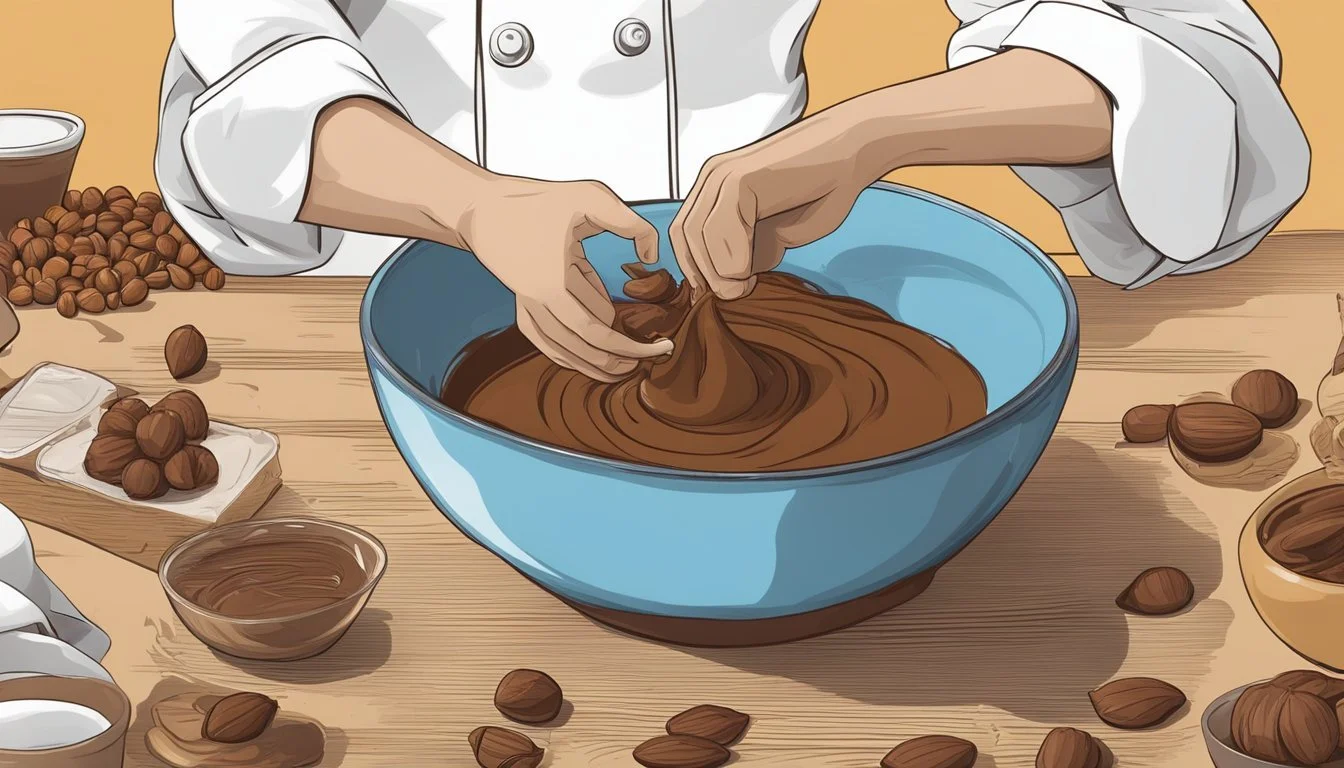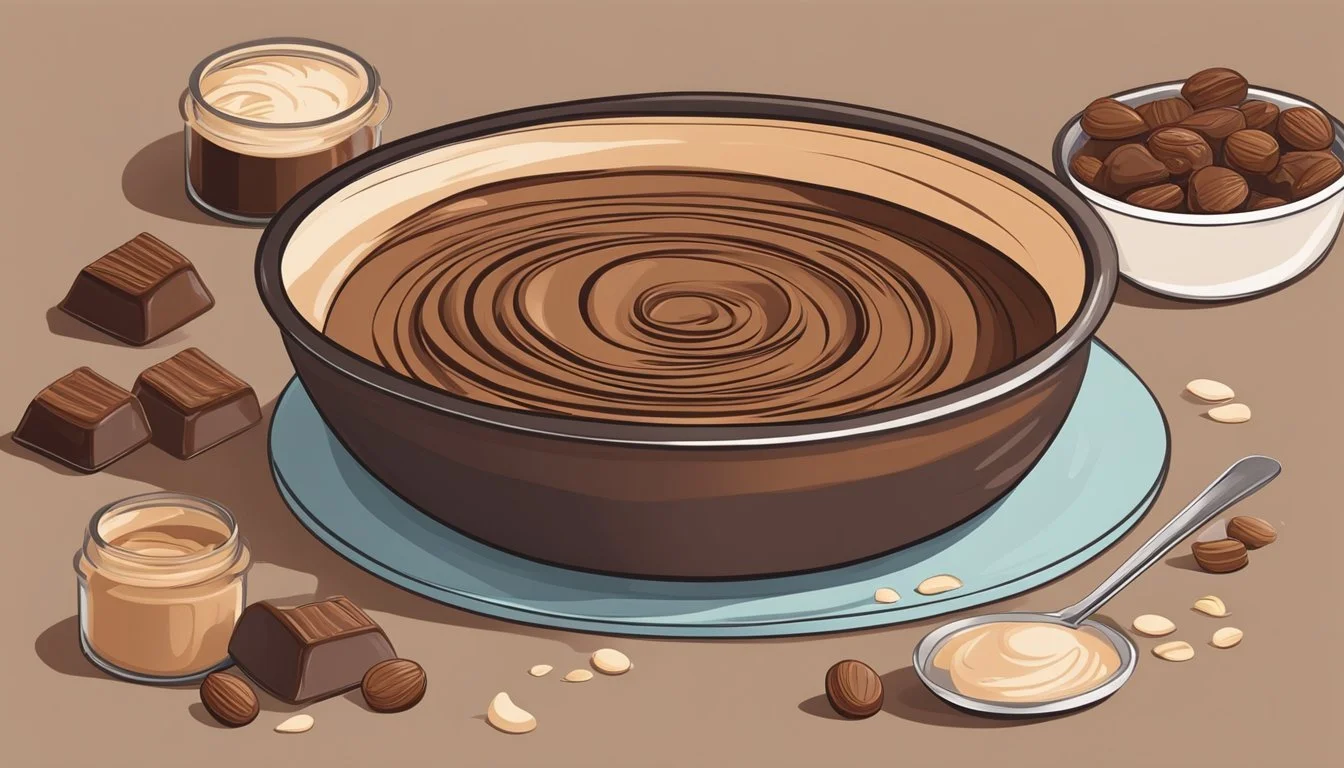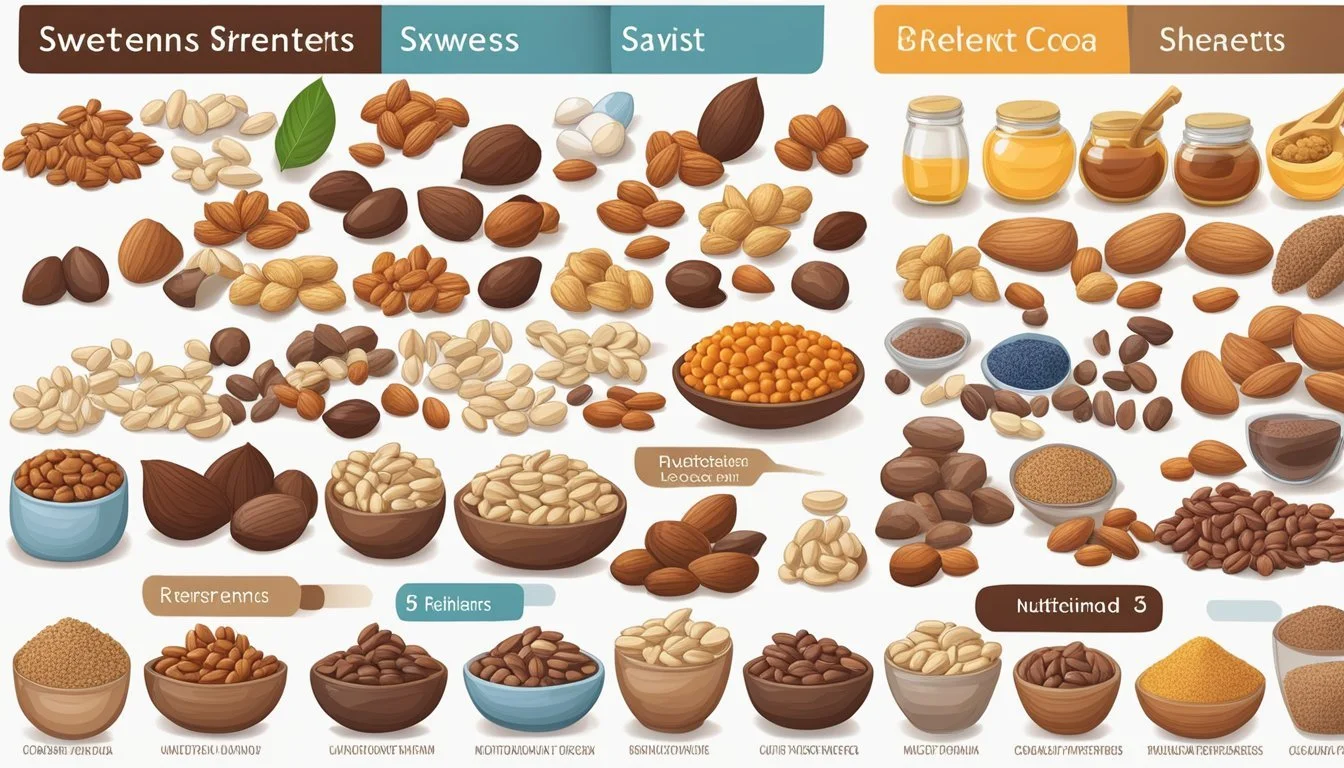Gianduja Substitutes
Best Alternatives for Delicious Desserts
Finding the perfect substitute for gianduja, the exquisite Italian chocolate hazelnut confection, can elevate your homemade treats or solve last-minute ingredient shortages. This blend of rich chocolate and creamy hazelnuts is often sought after for its smooth texture and unique flavor. When you can't source gianduja, there are other ingredients that can closely mimic its profile.
A great alternative to gianduja is a mixture of dark chocolate and hazelnut butter. This combination recreates the luxurious taste and creamy consistency that gianduja is known for. Hazelnut butter pairs well with high-quality dark chocolate to deliver a similar richness and depth, making it an excellent stand-in.
Another option is to use a commercially available chocolate-hazelnut spread, such as Nutella, which offers a similar flavor profile though it may be sweeter and less intense. For a more refined substitute in recipes that call for gianduja, blending milk chocolate with finely ground hazelnuts can also work well. Each alternative allows you to enjoy the beloved flavors of gianduja even when the original ingredient is not at hand.
Understanding Gianduja
Gianduja is an Italian confection that uniquely blends chocolate and hazelnut paste. Its historical roots trace back to Turin, Italy, where it was first created. Traditional recipes emphasize the importance of high-quality ingredients.
History and Origin of Gianduja
Gianduja originated in Turin, Italy, during the early 19th century. The blend was developed when chocolate was scarce due to Napoleonic trade blockades. Clever confectioners started using locally abundant hazelnuts to stretch their supplies.
The name Gianduja comes from "Gianduia," a character in Italian commedia dell'arte, who became a symbol of the Piedmont region. This region is renowned for its premium hazelnuts, which play a crucial role in the creation of the confection.
Traditional Gianduja Ingredients
The classic gianduja recipe includes a blend of chocolate, hazelnut paste, and sugar. Typically, dark or milk chocolate is used, allowing for variations in flavor. The hazelnut paste is made from finely ground hazelnuts, often from the Piedmont region, known for their superior quality.
To achieve a smooth texture, gianduja makers may add cocoa powder and fat. The balance of sweetness, chocolate richness, and creamy hazelnut flavor characterizes the best gianduja. High-quality ingredients are paramount, particularly the hazelnuts and chocolate, ensuring a velvety mouthfeel and rich taste.
Gianduja stands out in various applications, from spreads to fillings for baked goods, showcasing its versatility and timeless appeal.
Types of Gianduja Substitutes
When looking for gianduja substitutes, options vary based on dietary preferences and nutritional needs. Whether aiming to find nut-based alternatives, vegan solutions, or low-sugar options, there are practical replacements available.
Nut-Based Substitutes
Nut-based substitutes are ideal for those who still want a rich, nutty flavor. Almond or cashew spreads can replace hazelnut in gianduja. These nuts offer a similar creamy texture but with slightly different taste profiles. Almond and cashew butters combined with cocoa powder and a bit of vanilla extract can mimic the luxurious taste of gianduja.
Nutella, a well-known hazelnut spread, can also work as a substitute. However, Nutella contains additional ingredients such as palm oil and higher sugar content. For a more all-natural substitute, try making a homemade blend of roasted almonds or cashews mixed with dark chocolate and a touch of cocoa butter.
Vegan Substitutes
For those following a vegan diet, traditional gianduja, which often includes dairy, isn't suitable. Instead, use vegan gianduja or make your own using dairy-free milk and cocoa butter. Instead of milk products, incorporate plant-based options like coconut milk or almond milk.
To achieve a similar consistency, blend roasted hazelnuts, dark chocolate, and agave syrup or another vegan sweetener. This ensures a creamy and rich texture while maintaining a dairy-free profile. Vegan spreads like those based on sunflower seeds combined with cocoa can also offer a nut-free alternative that caters to differing dietary restrictions.
Low-Sugar and Sugar-Free Options
Reducing sugar intake is a priority for many, and finding gianduja substitutes with lower sugar content is simpler than it might seem. Utilize dark chocolate varieties that have higher cocoa content and lower sugar levels. Combine these with unsweetened nut butters for a less sugary substitute.
For a sugar-free option, use natural sweeteners like stevia or erythritol. Mix these with roasted hazelnuts or almonds and melted dark chocolate to create a guilt-free alternative. Additionally, you can find commercial sugar-free hazelnut spreads that prioritize lower carbohydrate content without compromising taste.
By exploring these different substitutes, people with various dietary needs and preferences can continue to enjoy the delicious taste of gianduja.
Homemade Gianduja Alternatives
Creating your own gianduja at home allows for unique flavor customization while using simple ingredients and tools. From basic mixtures to creative add-ins, homemade options can cater to various tastes.
Preparing a Basic Gianduja Mixture
To create a basic gianduja, you need hazelnuts, chocolate, and a sweetener.
Start by roasting hazelnuts at 350°F (175°C) for about 10-12 minutes until golden brown.
Once cooled, remove the skins by rubbing the nuts in a kitchen towel.
Blend the hazelnuts in a food processor until they form a smooth butter.
In a double boiler, melt dark chocolate over medium heat. Combine the melted chocolate and the hazelnut butter, mixing until smooth. For sweetness, add maple syrup or icing sugar. Blend again until the mixture is creamy and well combined. Store in an airtight container to maintain freshness.
Flavor Variations and Add-Ins
Experiment with different flavors to enhance your gianduja.
Vanilla Powder: Adds a rich, aromatic touch.
Cinnamon: Introduces a warm, spicy note.
Chili Flakes: Provides a subtle heat and complexity.
Roasted Nuts: Use almonds or pecans for different nutty flavors.
To incorporate these, mix them into the gianduja during the blending step. For natural sweetness without sugar, consider using dates or honey. Always ensure any added ingredients are finely ground to maintain a smooth texture. These variations allow you to tailor the gianduja to your preference and culinary needs.
Gianduja in Baking and Desserts
Gianduja, a lush combination of chocolate and hazelnut, can be a versatile ingredient in both confectionery and desserts, enhancing flavor and texture.
Incorporating Gianduja in Confectionery
In truffle-making, gianduja offers a smooth, nutty core. Begin by melting chocolate over a double boiler and incorporating hazelnut paste. Allow the mixture to cool, then form it into small balls. Coat with tempered chocolate to create a delicate shell.
For chocolate bars, layering gianduja adds a creamy element. Melt dark chocolate, spread a layer of gianduja, and finish with another chocolate layer. Refrigerate until firm, then cut into bite-sized pieces. This method balances the richness of chocolate with the nutty profile of gianduja.
Gianduja as a Dessert Component
In cakes and pastries, gianduja acts as both filling and frosting. Spread gianduja between cake layers for enhanced flavor. For pastries, use it as a filling in croissants or danishes. Its smooth texture complements the flaky layers.
When making desserts like mousse or cheesecake, fold gianduja into the mixture. It integrates seamlessly, lending a rich, nutty chocolate flavor. Additionally, consider gianduja for topping ice cream or as a dip for fruits, adding sophistication and depth.
Nutritional Profile and Health Benefits
Gianduja substitutes can be both nutritious and beneficial to health. This section covers key nutritional components like caloric content, macronutrients, and the specific health benefits provided by hazelnuts.
Caloric Content and Macronutrients
Gianduja, primarily made from hazelnuts and chocolate, contains several macronutrients. For instance, whole hazelnuts are calorie-dense, providing approximately 180 calories per ounce.
Besides calories, hazelnuts offer a substantial amount of protein—about 4 grams per ounce. They are also a great source of fiber with around 3 grams per ounce, which aids in digestion and overall gut health.
Gianduja substitutes may utilize different types of chocolate, affecting fat content. On average, hazelnuts contribute about 17 grams of fat per ounce, 13 grams of which are healthy monounsaturated fats.
Benefits of Hazelnuts
Hazelnuts bring a range of health benefits, attributed to their rich nutrient profile. They are particularly abundant in antioxidants, which can help reduce oxidative stress and inflammation in the body. Raw, skinned hazelnuts tend to offer higher antioxidant levels.
Including hazelnuts in one’s diet may contribute to heart health. This is due to their content of monounsaturated fats and fiber, both of which can improve cholesterol levels. Additionally, hazelnuts provide minerals like magnesium and zinc, essential for various bodily functions.
Incorporating these nuts into gianduja substitutes can enhance the nutritional information and overall benefits of the final product. This makes hazelnut-based gianduja a potentially healthy option for consumers focused on healthy eating.
Food Pairings and Culinary Uses
Gianduja is a versatile ingredient that can enhance both sweet and savory dishes. Its unique flavor pairs well with various foods and adds richness to recipes across different cuisines.
Gianduja as a Spread
Gianduja is commonly used as a spread, providing a rich, sweet nutty flavor that elevates simple snacks into gourmet treats. Spread it on bread or toast for an indulgent breakfast or afternoon treat. Its creamy texture makes it perfect for spreading on crackers or as a filling for pastries.
For a more sophisticated snack, pair gianduja with fresh fruits like strawberries or bananas. The combination of the sweet gianduja and the natural acidity of the fruit creates a balanced flavor profile. Gianduja is also delightful when spread on crepes or pancakes, adding a decadent touch to these breakfast classics.
Gianduja in Savory Applications
While traditionally used in sweet dishes, gianduja can also bring an unexpected depth to savory recipes. It can be incorporated into sauces for meat dishes, particularly those featuring game meats or pork. The nutty sweetness complements the rich, robust flavors of the meat.
One innovative use is adding a small amount of gianduja to a tomato sauce to balance acidity and add complexity. This can be particularly effective in enhancing the flavors of a pasta dish. Gianduja can also be paired with olive oil to create a unique dressing for salads or as a finishing touch on a pizza.
Incorporating gianduja into savory dishes can surprise and delight the palate, adding a new dimension to familiar recipes. Its versatility makes it a valuable addition to any culinary repertoire, whether in traditional or creative applications.
Storage and Shelf Life
Gianduja spreads need careful storage to maintain their quality and extend their shelf life. Recognizing signs of spoilage is equally important to ensure safe consumption.
Proper Storage Techniques
Store gianduja in a cool, dry place away from direct sunlight. Exposure to heat can cause the oils from the hazelnuts to separate and become rancid. Ideal storage temperature is between 50-70°F (10-21°C).
A refrigerator can be used, but it may alter the texture, making it firmer and harder to spread. If refrigerated, return it to room temperature before use.
Airtight containers are recommended to prevent moisture and odors from affecting the spread. Using a tightly sealed glass jar is particularly effective.
Signs of Spoilage
Changes in color can indicate that gianduja is past its prime. Look for any darkening or unusual spots that deviate from its original appearance.
Texture changes are another sign. If the spread becomes grainy or excessively hard, it could be an indicator of spoilage.
Odor is a clear indicator of gianduja's condition. Rancid smells or any off odors suggest that the oils have degraded.
Regularly check for mold on the surface, as it clearly indicates spoilage. Consumption should be avoided in such instances for food safety.
By following these guidelines, the gianduja can maintain its quality and be enjoyed safely over an extended period.
Gianduja and Social Media Sharing
Gianduja, a delightful blend of chocolate and hazelnuts, has found its place in various social media platforms, enhancing user experiences through shared recipes and community discussions. Key platforms such as Pinterest and Facebook play a significant role in spreading the love for this luscious confection.
Recipes and Creations on Pinterest
On Pinterest, users often share their favorite gianduja recipes, inspiring others with eye-catching visuals. From traditional gianduja to vegan adaptations, these posts include everything from ingredients lists to step-by-step preparation images. Recipe boards dedicated to gianduja attract engagement through likes, comments, and repins.
Creators often highlight the use of high-quality dark chocolate and finely ground hazelnuts. Visual inspiration plays a crucial role in engaging the audience, making each recipe appealing and easy to follow. People save these pins to try later, fostering a community of gianduja enthusiasts who enjoy experimenting with different flavors and techniques.
Discussion and Tips on Facebook
Facebook is another hub for gianduja aficionados. Groups and pages dedicated to chocolate and dessert making often feature gianduja tips and discussions. Here, users post about their experiences, ask questions, and share advice on perfecting gianduja.
Community engagement is significant in these groups, as members share their successes and troubleshoot issues together. Comments and reactions help build a supportive environment. Frequently discussed topics include the best types of chocolate to use, alternative nut options, and techniques for achieving the perfect consistency. Facebook’s interactive nature helps sustain an active gianduja dialogue, fostering an inclusive space for both beginners and seasoned experts.







